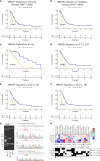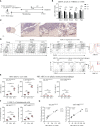Metabolic-related gene pairs signature analysis identifies ABCA1 expression levels on tumor-associated macrophages as a prognostic biomarker in primary IDHWT glioblastoma
- PMID: 36248907
- PMCID: PMC9561761
- DOI: 10.3389/fimmu.2022.869061
Metabolic-related gene pairs signature analysis identifies ABCA1 expression levels on tumor-associated macrophages as a prognostic biomarker in primary IDHWT glioblastoma
Abstract
Background: Although isocitrate dehydrogenase (IDH) mutation serves as a prognostic signature for routine clinical management of glioma, nearly 90% of glioblastomas (GBM) patients have a wild-type IDH genotype (IDHWT) and lack reliable signatures to identify distinct entities.
Methods: To develop a robust prognostic signature for IDHWT GBM patients, we retrospectively analyzed 4 public datasets of 377 primary frozen tumor tissue transcriptome profiling and clinical follow-up data. Samples were divided into a training dataset (204 samples) and a validation (173 samples) dataset. A prognostic signature consisting of 21 metabolism-related gene pairs (MRGPs) was developed based on the relative ranking of single-sample gene expression levels. GSEA and immune subtype analyses were performed to reveal differences in biological processes between MRGP risk groups. The single-cell RNA-seq dataset was used to examine the expression distribution of each MRG constituting the signature in tumor tissue subsets. Finally, the association of MRGs with tumor progression was biologically validated in orthotopic GBM models.
Results: The metabolic signature remained an independent prognostic factor (hazard ratio, 5.71 [3.542-9.218], P < 0.001) for stratifying patients into high- and low-risk levels in terms of overall survival across subgroups with MGMTp methylation statuses, expression subtypes, and chemo/ratio therapies. Immune-related biological processes were significantly different between MRGP risk groups. Compared with the low-risk group, the high-risk group was significantly enriched in humoral immune responses and phagocytosis processes, and had more monocyte infiltration and less activated DC, NK, and γδ T cell infiltration. scRNA-seq dataset analysis identified that the expression levels of 5 MRGs (ABCA1, HMOX1, MTHFD2, PIM1, and PTPRE) in TAMs increased with metabolic risk. With tumor progression, the expression level of ABCA1 in TAMs was positively correlated with the population of TAMs in tumor tissue. Downregulation of ABCA1 levels can promote TAM polarization towards an inflammatory phenotype and control tumor growth.
Conclusions: The metabolic signature is expected to be used in the individualized management of primary IDHWT GBM patients.
Keywords: ABCA1; metabolic-related gene pairs; primary glioblastoma; prognosis; tumor-associated macrophages; wild-type isocitrate dehydrogenase.
Copyright © 2022 Wang, Li, Zuo, Kong, Wei and Dong.
Conflict of interest statement
The authors declare that the research was conducted in the absence of any commercial or financial relationships that could be construed as a potential conflict of interest.
Figures







Similar articles
-
A map of the spatial distribution and tumour-associated macrophage states in glioblastoma and grade 4 IDH-mutant astrocytoma.J Pathol. 2022 Oct;258(2):121-135. doi: 10.1002/path.5984. Epub 2022 Jul 25. J Pathol. 2022. PMID: 35723032
-
A nuclear transport-related gene signature combined with IDH mutation and 1p/19q codeletion better predicts the prognosis of glioma patients.BMC Cancer. 2020 Nov 9;20(1):1072. doi: 10.1186/s12885-020-07552-3. BMC Cancer. 2020. PMID: 33167941 Free PMC article.
-
Molecular classification of IDH-mutant glioblastomas based on gene expression profiles.Carcinogenesis. 2019 Jul 20;40(7):853-860. doi: 10.1093/carcin/bgz032. Carcinogenesis. 2019. PMID: 30877769 Free PMC article.
-
COVPRIG robustly predicts the overall survival of IDH wild-type glioblastoma and highlights METTL1+ neural-progenitor-like tumor cell in driving unfavorable outcome.J Transl Med. 2023 Aug 8;21(1):533. doi: 10.1186/s12967-023-04382-2. J Transl Med. 2023. PMID: 37553713 Free PMC article.
-
The Multifunctional Role of EMP3 in the Regulation of Membrane Receptors Associated with IDH-Wild-Type Glioblastoma.Int J Mol Sci. 2021 May 17;22(10):5261. doi: 10.3390/ijms22105261. Int J Mol Sci. 2021. PMID: 34067658 Free PMC article. Review.
Cited by
-
A pan-cancer analysis targeting the oncogenic role of ATP-binding cassette transporter A1 in human tumors.Front Oncol. 2025 Apr 14;15:1513992. doi: 10.3389/fonc.2025.1513992. eCollection 2025. Front Oncol. 2025. PMID: 40297807 Free PMC article. Review.
-
The Impact of Metabolic Rewiring in Glioblastoma: The Immune Landscape and Therapeutic Strategies.Int J Mol Sci. 2025 Jan 14;26(2):669. doi: 10.3390/ijms26020669. Int J Mol Sci. 2025. PMID: 39859381 Free PMC article. Review.
-
Oncolytic viruses engineered to enforce cholesterol efflux restore tumor-associated macrophage phagocytosis and anti-tumor immunity in glioblastoma.Nat Commun. 2023 Jul 20;14(1):4367. doi: 10.1038/s41467-023-39683-z. Nat Commun. 2023. PMID: 37474548 Free PMC article.
-
Microglia and Brain Macrophages as Drivers of Glioma Progression.Int J Mol Sci. 2022 Dec 9;23(24):15612. doi: 10.3390/ijms232415612. Int J Mol Sci. 2022. PMID: 36555253 Free PMC article. Review.
References
Publication types
MeSH terms
Substances
LinkOut - more resources
Full Text Sources
Medical
Miscellaneous

